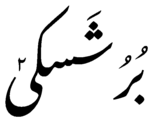
Back بروشسكي Arabic Idioma burushaski AST Buruşaski dili Azerbaijani بوریشاسکیلر AZB Бурушаскі BE-X-OLD Бурушаски Bulgarian বুরুশাস্কি Bengali/Bangla Bourouchaskeg Breton Buruixaski Catalan بوروشەسکی CKB
| Burushaski | |
|---|---|
| بُرُݸشَسکݵ | |
 Burushaski written in Nastaliq style. | |
| Native to | Pakistan, India |
| Region | Hunza, Nagar, Ghizer, Gilgit (Pakistan) and Hari Parbat, Jammu and Kashmir (India)[1] |
| Ethnicity | Burusho |
Native speakers | 130,000 (2018–2020)[2] |
| Dialects |
|
| Language codes | |
| ISO 639-3 | bsk |
| Glottolog | buru1296 |
| ELP | Burushaski |
 | |
 Burushaski is classified as Vulnerable by the UNESCO Atlas of the World's Languages in Danger | |
Burushaski (/ˌbʊrʊˈʃæski/;[3] Burushaski: بُرُݸشَسکݵ, romanized: burúśaski,[4] IPA: [bʊˈruːɕʌskiː]) is a language isolate, spoken by the Burusho people, who predominantly reside in the northern Gilgit-Baltistan, Pakistan.[5][6] There are also a few hundred speakers of this language in the northern Jammu and Kashmir, India.[5][7] In Pakistan, Burushaski is spoken by people in the Hunza District, the Nagar District, the northern Gilgit District, the Yasin Valley in the Gupis-Yasin District and the Ishkoman Valley of the northern Ghizer District. Their native region is located in northern Gilgit–Baltistan. It also borders with the Pamir corridor to the north. In India, Burushaski is spoken in Botraj Mohalla of the Hari Parbat region in Srinagar.[1][8] It is generally believed that the language was spoken in a much wider area in the past. It is also known as Werchikwar and Miśa:ski.[9]
Due to the effects of dominant languages in Pakistani media, such as Urdu, Standard Punjabi and English, and the religious impact of Arabic and Persian, Burushaski, like other languages of Pakistan, is continuously expanding its vocabulary with loanwords.[10]
- ^ a b Munshi, Sadaf (2006). Jammu and Kashmir Burushashki: Language, Language Contact, and Change. The University of Texas at Austin. p. 6.
The J & K Burushos – speakers of the variety of Burushaski spoken in Jammu & Kashmir (henceforth "JKB") in India – are settled in and around a small locality by the foothills of Hari Parbat Fort in Srinagar, the capital of the state of Jammu & Kashmir (henceforth "J & K").
- ^ Burushaski at Ethnologue (27th ed., 2024)

- ^ Laurie Bauer, 2007, The Linguistics Student’s Handbook, Edinburgh
- ^ Cite error: The named reference
b-u-dict-vol1was invoked but never defined (see the help page). - ^ a b "Pakistan's 'Burushaski' Language Finds New Relatives". NPR. 20 June 2012. Retrieved 23 September 2017.
It's spoken by about 90,000 people, the Burusho people, and nearly all of them live in Pakistan. A few hundred live in India.
- ^ "Encyclopedia – Britannica Online Encyclopedia". Original.britannica.com. Retrieved 14 September 2013.
- ^ Ahmed, Musavir (2016). "Ethnicity, Identity and Group Vitality: A study of Burushos of Srinagar". Journal of Ethnic and Cultural Studies. 3 (1): 1–10. doi:10.29333/ejecs/51. ISSN 2149-1291.
- ^ "Dissertation Abstracts". Linguist List. Archived from the original on 2 February 2017. Retrieved 14 September 2013.
- ^ "Burushaski". Ethnologue. 19 February 1999. Retrieved 14 September 2013.
- ^ Shams, Shammim Ara (2020). "The Impact of Dominant Languages on Regional Languages: A Case Study of English, Urdu and Shina". Pakistan Social Sciences Review. 4 (III): 1092–1106. doi:10.35484/pssr.2020(4-III)79.
© MMXXIII Rich X Search. We shall prevail. All rights reserved. Rich X Search